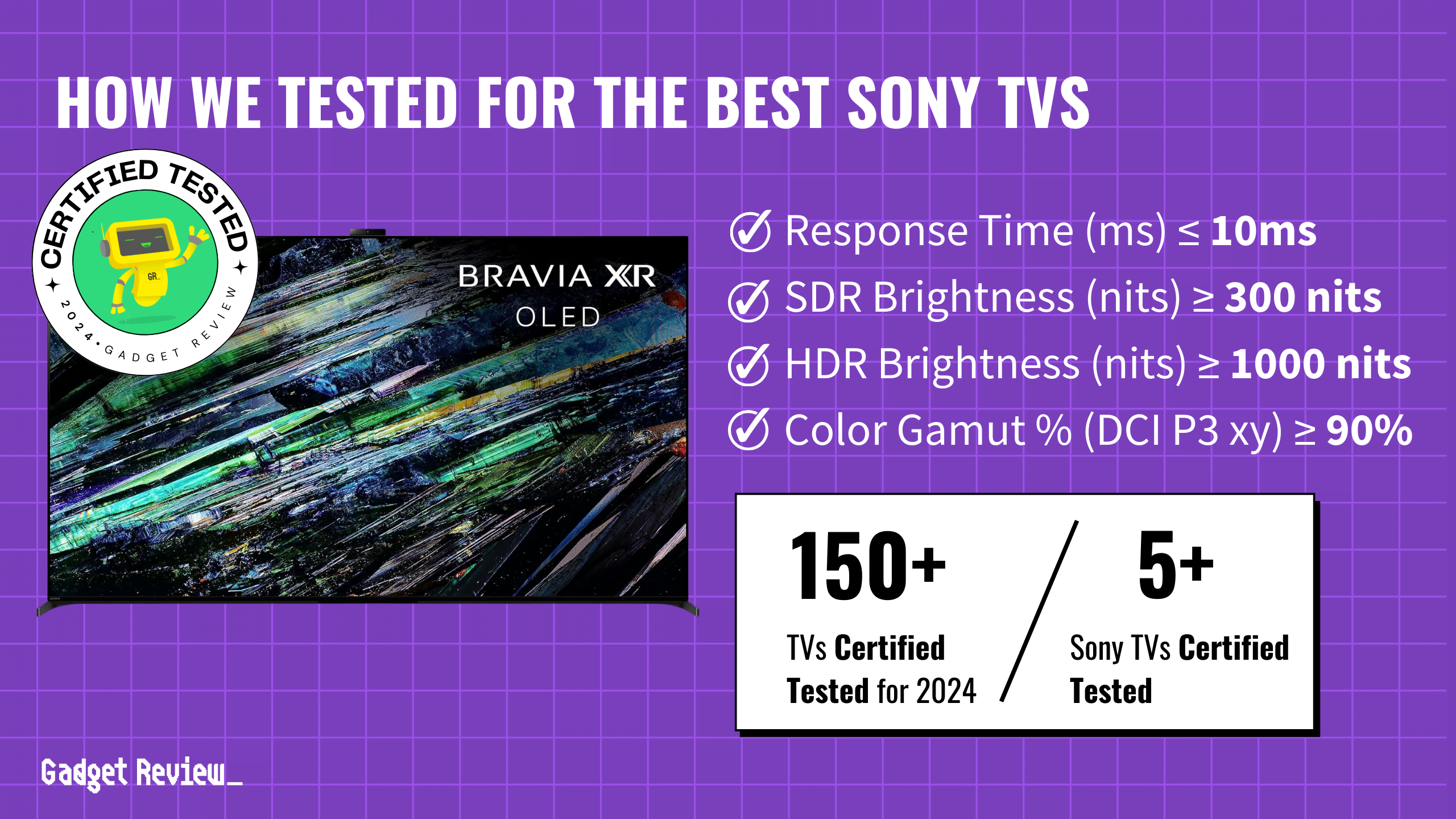Sony TVs stand out as some of the top-rated TVs thanks to their exceptional color accuracy and impressive out-of-the-box performance, making them a premium choice for movie enthusiasts. With excellent EOTF (Electro-Optical Transfer Function) and a wide color gamut, these TVs ensure true-to-life visuals right from the start without the need for extensive calibration.
While Sony’s offerings come at a higher price point compared to other brands, the investment is justified by the quality of the viewing experience, particularly for cinematic content. However, it’s worth noting that for gaming or fast-paced sports, there might be more specialized options available. Our recommendations, meticulously curated based on extensive testing data, focus on Sony models that excel in delivering unparalleled picture quality for those who value a top-tier movie-watching experience.
How Did We Rank the Best Sony TVs?
To assess how high or low quality a Sony TV actually is, one must evaluate specific testing criteria against reference industry standards. Using our thorough TV Testing Methodology, we determined there are 6 criteria below (3 required, 3 nice to have) that ensure your content looks as good as the creator intended it.
Test Criteria
- SDR Brightness: Equal to or greater than 300 nits, ensuring a bright and clear display under any lighting conditions.
- HDR Brightness: 1000 nits or more, to reveal the finest details in high dynamic range content.
- Color Accuracy: At least 90% of the DCI P3 color gamut, providing rich and vibrant colors.
“Nice To Haves”
- Contrast Ratio: 10,000:1 or higher, offering deep blacks and bright whites for an exceptional viewing experience.
- EOTF Accuracy: Delta E less than or equal to 0.018, for precise brightness and contrast across the board.
- Fast Response Time: 10ms or less, ensuring smooth transitions without motion blur.
We’ve redefined TV buying guides, setting us apart from any other site on the planet. Our unique approach combines in-house verification with a comprehensive dataset from over 200+ trusted sites, focusing on key testing metrics to rank the top-rated Sony TVs. Testing data and specs include SDR brightness of at least 300 nits, HDR brightness of 1000 nits and above, and color accuracy with a minimum of 90% DCI P3 color gamut. We aggregate and analyze this data from 158+ TVs, ensuring our recommendations meet your specific needs. For the best Sony TV, this means delivering unparalleled resolution, exceptional brightness and color fidelity for an immersive viewing experience. Our commitment to unbiased reviews is powered by our ‘True Score’ system, targeting low quality and fake reviews. Commissions fund this mission. No bias. No BS.
Latest Updates
- 03/06/2024: Completely and thoroughly overhauled the guide to include the best and latest Sony TVs.
- 11/29/2023: Republished the list to include TVs based on our True Score system.
Top Best Sony TVs For 2025
Prices accurate at the time of publishing

Best Overall

Runner Up

Best Value

Best Budget

Best Mid-Range

Premium Pick
Sony A95L OLED TV
Exemplifies peak color fidelity and accuracy with 99.96% DCI P3 coverage. Ideal for home theaters and sports, though premium-priced and less suited for competitive gaming.
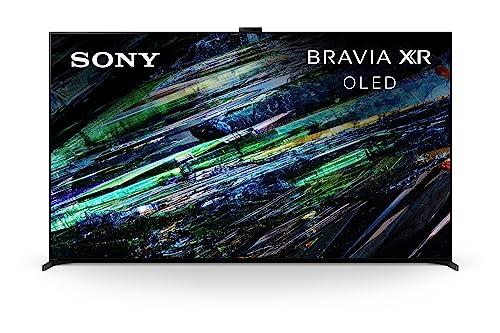
True Score
89926Experts
932kCustomers
Absolutely Fresh
 SAVE $200$1,798.00$1,598.00
SAVE $200$1,798.00$1,598.00Snapshot
Reasons to Buy
- Stellar picture quality in the dark
- High peak brightness
- Fast response time and low 4K input lag
- 120 Hz refresh rate
- Ultra-wide viewing angles
Reasons to Avoid
- Slightly high full HD input lag
- Slight purple haze
- No FreeSyc support
Specifications
Max Resolution 3840 x 2160 (4k) 
Backlight Type No Refresh Rate 120 Hz Display Type QD-OLED HDMI Inputs 4 
HDMI Type 2.0, HDMI 2.1 HDR Format Dolby Vision, HDR10, HLG 
HomeKit Compatible Yes 
LED Panel Type OLED 
Number of Audio Channels n/a 
Panel Type OLED Screen size 55", 65", 77" 
Smart Platform Android TV, Google TV 
Speaker Output 60 watts 
Sync Technology G-Sync 
VRR Yes All Specs
Test Results
SDR Brightness (nits) 309.5 HDR Brightness (nits) 1,262 Color Gamut % (DCI P3 xy) 99.96 Response Time (ms) 9.6 Contrast Ratio (x:1) 0 EOTF (600 nit delta) 0.0022 Color Gamut % (DCI P3 uv) 99.97 Color Gamut % (Rec 2020 xy) 85.78 Color Gamut % (Rec 2020 uv) 90.25 Color Gamut % (sRGB) 0 Color Gamut % (Rec 709) 99.9763 Color Gamut % (BT.2020) 89 Color Gamut % (Adobe RGB) 0 Color Gamut % (BT.709) 0 Input Lag (ms) 16.4 Color Washout (Degrees) 70 Color Shift (Degrees) 70 Brightness Loss (Degrees) 70 Reflections (%) 1 Low-Freq Extension (Hz) 84.76 Freq Response StdDev @ 70db 2.45 Freq Response StdDev @ 80db 2.39 Weighted Total Harmonic Distortion @80db 0.139 Intermodulation Distortion @80db 0.7 EOTF (1000 nit delta) 0.0019 EOTF (4000 nit delta) 0.0023 All Tests
All Retailers
- $1,598.00$1,798Save $200
Availability
In StockFree Shipping
No - $1,598.00$2,798Save $1
Availability
Free Shipping
- $1,999.99$2,800Save $800
Availability
In StockFree Shipping
No Availability
Free Shipping
Our Verdict
The Sony A95L OLED TV is one of the best TVs in Sony’s line up thanks to its pursuit of superior color fidelity and gamma accuracy. With a color gamut coverage of 99.96% in the DCI P3 xy space, it ensures that colors are vibrant and true-to-life, making every scene pop with unparalleled realism. Combined with the TV’s outstanding EOTF performance of 0.0022, the A95L is a phenomenal choice for home theater enthusiasts looking to get the most accurate possible picture when watching films.
If you’re a sports enthusiast, the A95L’s response time of 9.6 ms reduces motion blur in fast-moving scenes, keeping action crisp and free of motion blur. Its response time may not be the best in its class, but the A95L does have a best-in-class color washout threshold of 70 degrees, meaning that it’s the best possible choice for sports fans looking to get a TV that can handle big crowds at game day parties. For gamers, the decent response time, coupled with the A95L’s low input lag of 16.4ms is decent enough for casual gaming. However, it’s likely too slow for highly competitive gamers looking to maximize every advantage they can get when playing high intensity games.
As far as Sony OLEDs are concerned, the A95L is the brightest on our list, outputting an SDR brightness level of 309.5 nits and an HDR peak brightness of 1262 nits. This makes the TV able to deliver outstanding clarity and detail in both dim rooms and decently bright ones, though it may struggle in rooms with tons of strong, natural light.
Overall, the A95L is an excellent combination of high color accuracy, wide viewing angles and unbeatable gamma tracking, making it a fantastic option for home theater enthusiasts that need a TV that can deal with high ambient light. However, this performance comes with a price tag to match, as the A95L is also the most expensive TV on our list, and if you’re looking for a TV that can handle high intensity gaming, you may want to consider a different option.

Best Overall

Runner Up

Best Value

Best Budget

Best Mid-Range

Premium Pick
Sony A90K OLED TV
Offers vibrant colors and sharp response, making it great for sports and casual gaming in smaller spaces. A premium compact option with exceptional visual fidelity.
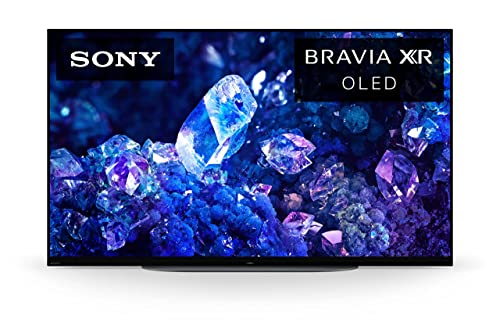
True Score
86867Experts
921kCustomers
Absolutely Fresh
 $1,298.00
$1,298.00Snapshot
Reasons to Buy
- Excellent picture quality
- High contrast ratio
- Low-tested response time and input lag
- Fast refresh rate and VRR support
- Wide viewing angles
Reasons to Avoid
- Limited HDR peak brightness
Specifications
Max Resolution 3840 x 2160 (4k) 
Backlight Type No Refresh Rate 120 Hz Display Type OLED HDMI Inputs 4 
HDMI Type HDMI 2.1 HDR Format Dolby Vision, HDR10, HLG 
HomeKit Compatible Yes 
Number of Audio Channels 7.1 
Panel Type RWBG Screen size 42", 48" 
Smart Platform Google TV 
Speaker Output 10W + 10W + 5W 
Sync Technology No 
VRR Yes All Specs
Test Results
SDR Brightness (nits) 288 HDR Brightness (nits) 593 Color Gamut % (DCI P3 xy) 99.375 Response Time (ms) 3 Contrast Ratio (x:1) 0 EOTF (600 nit delta) 0.004 Color Gamut % (DCI P3 uv) 99.67 Color Gamut % (Rec 2020 xy) 73.54 Color Gamut % (Rec 2020 uv) 78.83 Color Gamut % (sRGB) 0 Color Gamut % (Rec 709) 0 Color Gamut % (BT.2020) 71.2 Color Gamut % (Adobe RGB) 0 Color Gamut % (BT.709) 0 Input Lag (ms) 16.9 Color Washout (Degrees) 58 Color Shift (Degrees) 31 Brightness Loss (Degrees) 61 Reflections (%) 1.8 Low-Freq Extension (Hz) 126.99 Freq Response StdDev @ 70db 4.02 Freq Response StdDev @ 80db 4.58 Weighted Total Harmonic Distortion @80db 0.14 Intermodulation Distortion @80db 0.47 EOTF (1000 nit delta) 0.0041 EOTF (4000 nit delta) 0.0041 All Tests
All Retailers
- $1,298.00
Availability
In StockFree Shipping
No - $1,298.00$1,300Save $2
Availability
In StockFree Shipping
No - $1,299.99
Availability
In StockFree Shipping
No
Our Verdict
The Sony A90K OLED TV stands among Sony’s best TVs through a combination of excellent visual fidelity and responsiveness. Featuring a color gamut coverage of 99.38% in the DCI P3 xy space and an EOTF of 0.0040, the A90K reproduces vibrant, true-to-life colors that are only barely edged out by the (much more expensive) A95L. Combined with an SDR brightness of 288.0 nits and an HDR peak brightness of 593 nits, the TV also performs well in dim and moderately lit rooms. However, it is not well suited to being set in bright rooms, where the strong ambient light will hurt the overall picture quality.
It’s worth noting that the A90K is a smaller overall television, coming in sizes far smaller than the other options on our list. However, it still commands a premium price tag given the actual size of the screen. That said, the smaller size of the TV doesn’t exclude it from being an excellent option for sports fans, too. With a remarkable response time of 3.0 ms, the A90K significantly reduces motion blur in fast-paced scenes, keeping the fastest and most dynamic plays perfectly clear and crisp.
With a similar input lag to the A95L of 16.9 ms, the A90K is best suited to casual games. Competitive gamers will probably find the delay to be too much for critical moments, but the more casual crowd will find the delay between their actions and on-screen responses to be more than sufficient to keep gameplay feeling smooth.
The Sony A90K OLED TV is overall a good TV for most use cases, especially if you need something in a smaller form factor. The small size also means a smaller price tag, so if you’re on a budget and want quality over screen real estate. Given its size, the TV is still expensive, but will get you OLED’s infinite contrast and deep blacks. Coupled with outstanding responsiveness for sports and Sony’s signature color fidelity and EOTF performance, the TV is absolutely worth considering if you want crisp visuals and outstanding HDR content in a 48-inch package.
DID YOU KNOW 87% OF TV REVIEWERS ARE UNTRUSTWORTHY?
Our research found 28 of 210 TV reviewers can be trusted, and shockingly 1 out of 3 on Google Page 1 were fake reviews showing no proof of test claims. See our Expose and Trust List. This is why Gadget Review is committed to calculating the most accurate product scores on the web.
To do this, we give every TV review site a Trust Rating, which measures how trustworthy the site and their testing claims are. We then leverage AI & a machine learning model to combine and calculate the Trust Rating with data from experts and consumers to deliver the True Score, the web’s most accurate product quality rating.

Best Overall

Runner Up

Best Value

Best Budget

Best Mid-Range

Premium Pick
Sony Bravia X93L Mini LED TV
Best For Home Theater
Best for brightly lit rooms with high brightness and solid sports performance. Trades some color coverage for no burn-in risk, excelling in bright environments.
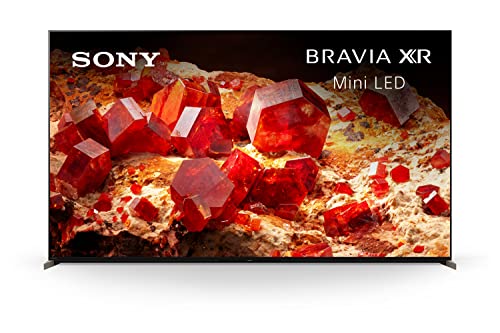
True Score
85856Experts
92543Customers
Absolutely Fresh
 $1,799.99
$1,799.99Snapshot
Reasons to Buy
- Outstanding picture quality
- High peak brightness and contrast ratio
- Fast refresh rate and VRR support
- Low input lag
Reasons to Avoid
- Narrow viewing angles
Specifications
Max Resolution 3840 x 2160 (4k) 
Backlight Type Full-Array Refresh Rate 120 Hz Display Type LED HDMI Inputs 4 
HDMI Type HDMI 2.1 HDR Format Dolby Vision, HDR10, HLG 
Number of Audio Channels 7.1 
Panel Type Mini-LED Screen size 65", 75", 85" 
Smart Platform Google TV 
Speaker Output 50 Watts 
Sync Technology G-Sync 
VRR Yes All Specs
Test Results
SDR Brightness (nits) 672 HDR Brightness (nits) 1,483 Color Gamut % (DCI P3 xy) 89.7367 Response Time (ms) 7.9 Contrast Ratio (x:1) 73,818 EOTF (600 nit delta) 0.005 Color Gamut % (DCI P3 uv) 95.37 Color Gamut % (Rec 2020 xy) 69.45 Color Gamut % (Rec 2020 uv) 75.33 Color Gamut % (sRGB) 96.7 Color Gamut % (Rec 709) 0 Color Gamut % (BT.2020) 73 Color Gamut % (Adobe RGB) 82.5 Color Gamut % (BT.709) 0 Input Lag (ms) 13.9 Color Washout (Degrees) 40 Color Shift (Degrees) 33 Brightness Loss (Degrees) 47 Reflections (%) 2.5 Low-Freq Extension (Hz) 84.76 Freq Response StdDev @ 70db 2.55 Freq Response StdDev @ 80db 2.45 Weighted Total Harmonic Distortion @80db 0.042 Intermodulation Distortion @80db 0.7 EOTF (1000 nit delta) 0.0057 EOTF (4000 nit delta) 0.0063 All Tests
All Retailers
- $1,799.99
Availability
In StockFree Shipping
No - $1,898.00$5,498Save $3,600
Availability
In StockFree Shipping
No Availability
Free Shipping
Our Verdict
If brightness and burn in are a concern, the Sony Bravia X93L offers up better brightness and no-burn in risk compared to the OLED offerings from Sony. With an exceptional SDR brightness of 672 nits and an HDR peak brightness of 1483 nits, the X93L is the go-to option for anyone needing to deal with very brightly lit rooms without losing picture quality. This elevated brightness level comes with a cost, however, as the color gamut coverage of 89.74% in the DCI P3 xy space means the X93L compromises on the usual exceptional color coverage Sony TVs are known for.
What the TV doesn’t compromise on is response time. Sports fans in particular will appreciate the X93L’s best-in-class response time of 7.9ms, which reduces motion blur in fast-moving scenes, ensuring that every moment of action is captured with crisp clarity. This performance is crucial for watching live sports, where the fast-paced nature of the games demands a display that can keep up without losing detail. The TV also features a surprisingly wide viewing angle of 40 degrees before color washout starts, giving it some of the best viewing angles a non-OLED TV can manage, and making the TV a decent option for crowds and game day parties.
The response time pairs well with X93L’s input lag of 13.9 ms, making the TV a great option for gamers, though competitive gamers will likely find the delay to be a bit too much for their liking. However, more casual gamers or fans of slower paced genres will be perfectly happy with the input lag.
If watching sports in a bright room is what you’re after, the Bravia X93L’s combination of high brightness and responsive performance is worth considering. Without the risk of burn-in and the naturally higher brightness that LEDs offer, the X93L will do better in brighter rooms and you won’t have to worry about static screen elements burning themselves into your screen. The TV can also handle casual streaming content and casual gaming content without any issue, especially if you need to fight ambient light.

DON’T SEE WHAT YOU’RE LOOKING FOR?
Sony is one of the best TV brands but if you have a particular use case check out the best gaming TVs, best OLED TVs or the best TV for sports. If you want to “future-proof” your setup, try our guide on the best 8k TVs and consider learning the differences between 4K vs 8K.
If you’re aiming for a home theater experience, exploring our recommendations for a high-end 75-inch TV could elevate your viewing to an extraordinary immersive spectacle. You can also learn how to connect a soundbar to your TV to enhance your audio experience, bringing theater-like quality right into your living room.

Our Approach to Testing Sony TVs

Evan Shepard/Gadget Review
Sony TVs offer exceptional color accuracy and out-of-the-box performance, ideal for movie enthusiasts with their impressive EOTF and wide color gamut. While they come at a premium price, the investment is justified for a top-tier cinematic experience, though other brands may be better suited for gaming or sports. Our recommendations, based on meticulous testing data, focus on Sony models that excel in delivering unparalleled picture quality for movie enthusiasts.
We collect and analyze testing data to simplify your decision-making process. Our guides ensure that all products listed meet the stringent requirements for your specific use case, like gaming with titles such as Call of Duty or other FPS games.
You may notice some of our graphs contain “Source: RTings”. This is to indicate that the data we’re showing off in a graph has come from a single source – because it’s the only source that actually tested the criteria and had data for it! Normally, our data is an average out of all of the various publications that test and provide data to give you a good idea of how a product is going to perform on average.
Which Criteria Matters for Testing Best Sony TVs?
By focusing on these criteria (3 required, 3 nice to have), anyone can quickly and easily compare these TVs and how they’ll perform. This helps you make an informed decision and purchase a TV that will fit into your small or tight space.
| CRITERIA | RANGE | REQUIRED | DEFINITION |
|---|---|---|---|
| SDR Brightness | 300+ nits | Yes | Assess the luminance of your display when operating in Standard Dynamic Range (SDR) mode. |
| HDR Brightness | 1000+ nits | Yes | Determine the luminance of your display in High Dynamic Range (HDR) mode. |
| Color Gamut (DCI P3 xy) | >= 90% | Yes | Evaluate the extent to which a TV can reproduce a specified spectrum of colors. |
| EOTF | 0.018 | No (nice to have) | Standard that governs how a display interprets and renders brightness and color. |
| Response Time | <=10ms | No (nice to have) | Time required for a pixel to transition from one color to another and then return to its original color. |
| Contrast Ratio | >= 10,000 | No (nice to have) | The ratio between the brightest white and darkest black that the screen can display. |
Our Trusted Data Sources
(Publication category Score is 80%+)
We looked at 210+ TV reviewers and while 24 are trustworthy (60%+ Trust Rating), we only use data from the testers that are “very trusted” which means a Trust Rating above 70%. The three we have listed below are our most trusted for TVs, along with our own in-house TV expert.
- Evan Shepard – Gadget Review
- Matthew Lopes – RTings, MuckRack
- Will Greenwald – PCMag, MuckRack, Twitter
- David Katzmaier – CNET, MuckRack, Twitter
Interested in a comprehensive analysis of our data sources? We’ve got you covered. Below, you’ll find a detailed list of every TV review website we’ve identified, organized by their respective Trust Ratings from highest to lowest. But we didn’t stop there. We’ve meticulously reviewed each publication and verified the data by checking whether the authors have bio links to MuckRack or LinkedIn. We’re committed to not only checking the facts but ensuring their veracity.
Best Sony TVs Test Data & Results
1. SDR & HDR Brightness TV Test Results
In well-lit rooms, the brightness level of your Sony TV, quantified in nits, is key to a great viewing experience. A TV that doesn’t meet the brightness requirement will struggle against natural and artificial light, resulting in a dim, lackluster image. Essentially, nits measure how well your TV can stand up to light interference, with higher values ensuring a sharper, more vivid display.
For standard viewing on the best Sony TV, you should look for at least 300 nits to strike the right balance between clarity and color quality in standard dynamic range (SDR) content. For high dynamic range (HDR) content, which offers richer colors and greater contrast, a minimum of 1000 nits is ideal to truly appreciate the enhanced visuals. These brightness levels are recommended to ensure your TV performs well in bright settings, allowing you to enjoy your shows and movies without any loss in detail or quality. Aim for these minimums: SDR Brightness >= 300 nits; HDR Brightness >= 1000 nits for the optimal experience.
Discover the top Sony TVs, ranked from brightest to least.
Brightness
SDR: 300+ nits
HDR: 1000+ nits
Acceptable range of performance
Definition: Maximum brightness in a specified pattern size window. Most commonly measured in a 10% or 100% white window.
Units of Measurement: nits (alternatively cd/m²)
Tools to Measure: TV, luminance meter
Why It’s Important:
Brightness helps counter ambient light so that details and colors don’t wash out and get lost.
SDR Brightness (in nits, higher is better)
HDR Brightness (in nits, higher is better)
2. Color Gamut (DCI P3 xy) TV Test Results
Color Gamut
>= 90%
Acceptable range of performance
Definition: The TV’s capability to display a spectrum of colors.
Units of Measurement: % (color space coverage in percent)
Tools to Measure: Colorimeter
Why It’s Important:
Inaccurate colors compromise the authenticity of the content.
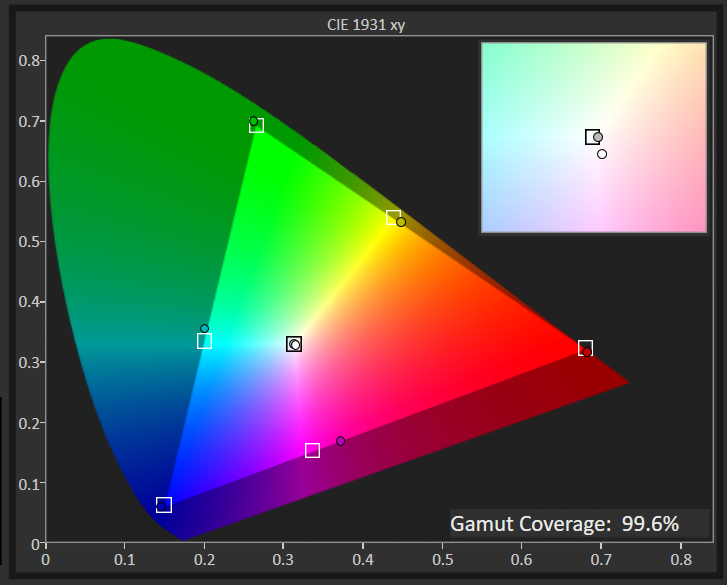
Color gamut defines the range of colors a TV can reproduce, directly affecting how vibrant and true-to-life the images look. A wide color gamut in a TV brings out richer, more vivid colors – from the lush greens of a garden to the bright colors of animated characters, enhancing your viewing experience to closely mimic real life.
This concept is technically measured against standards like the DCI P3 xy, a benchmark for high-quality visuals. A Sony TV covering a higher percentage of this color space can display colors more accurately and vividly.
For those who prioritize vibrant and immersive visuals, aiming for a Sony TV with a color gamut of 90% or higher on the DCI P3 xy scale is ideal. This ensures that the content you watch is as vibrant and lifelike as possible.
Below are the top Sony TVs, ordered by color gamut.
DCI P3 XY Color Gamut (as a %; high is better)
3. EOTF Test Results
The Electro-Optical Transfer Function (EOTF) plays a critical role in ensuring the content on your TV looks exactly as the creator intended. This technical feature adjusts your screen’s brightness levels, ensuring every scene, from the darkest shadows to the brightest highlights, is displayed with true-to-life accuracy.
In rooms flooded with light, a TV that nails EOTF calibration shines by preserving the intended contrast and detail in the picture despite the challenging conditions. It balances the brightness so that images remain vibrant and full of detail, unaffected by the glare of ambient light.
A TV that excels in managing EOTF offers an immersive and authentic viewing experience. It brings creators’ visions to life, accurately rendering every scene with the proper light and dark levels, no matter the lighting in your room. This means you get a consistent, realistic picture that captures the full spectrum of colors and contrasts, from the subtlest hues to the most intense explosions.
Below are all the small TVs on our list, ordered by EOTF.
EOTF
< 0.018 (600 nit Δ)
Acceptable range of performance
Definition: How your TV interprets and renders the luminance data from content and translates it to be represented on screen. If EOTF/Gamma tracking is too low or too high, it will result in an over-brightened or over-darkened image from reference.
Units of Measurement: this test measures for the delta from the standard
Tools to Measure: Luminance colorimeter
Why It’s Important:
EOTF ensures that the game is displayed (color and HDR brightness) as the creator intended it
EOTF (source: rtings.com – 0 = no data exists; lower is better)
4. Response Time TV Test Results
Response Time
1ms-10ms
Acceptable range of performance
Definition: Speed at which a pixel transitions from one color to another
Units of Measurement: milliseconds (ms)
Tools to Measure: Screen, camera, test software
Why It’s Important:
A faster response time means less blur and thus more accuracy
A slow response time on a TV during fast-paced scenes is like trying to watch a thrilling movie with a foggy lens. Imagine settling in for an action-packed sequence, only to have the swift movements turn into a blur, robbing you of the crisp, clear detail you crave. This isn’t just a minor annoyance; it’s a major detriment to your viewing experience, leaving you with a picture marred by motion blur and visual artifacts.
So, what exactly is response time? It measures how quickly a pixel on your TV can change from one color to another. In the context of watching fast-moving content or enjoying dynamic scenes on a TV, a low response time is crucial. A response time of 15 ms or lower is good, but if you plan on gaming on this set, aim for a response time of 10 ms or lower. At these levels, your Sony TV ensures smooth transitions and sharp visuals, making every scene come to life without any distracting blurs or delays.
Below are the top Sony TVs, ordered by response time, all exceeding our testing criteria.
Response Time (in milliseconds; lower is better)
5. Contrast Ratio Test Results
For Sony TV enthusiasts, a solid contrast ratio is crucial for enjoying your favorite TV shows or movies, especially in darker settings. This feature directly impacts how lifelike and dynamic the picture appears on your screen, ensuring that dark scenes are displayed with clear, crisp blacks instead of murky grays and bright scenes retain their detail without appearing washed out.
Put simply, the contrast ratio is all about the range of luminance a TV can produce, from the deepest blacks to the brightest whites. It’s what brings depth to the image, enhancing the realism of every scene. Watching a movie in the dark, for example, the difference between a TV with a poor contrast ratio and one with a high ratio is stark: the former struggles, blending shadows into a flat gray, while the latter delivers true black, making night scenes more immersive and detailed.
Ideally, a contrast ratio of 10,000:1 is what you should aim for in a small TV. This level of luminance variance ensures that you’re getting a picture quality that can handle the nuances of lighting in any scene, providing a viewing experience that’s both rich and engaging. Note: OLED TVs have infinite contrast ratio, indicated by “0.”
Below are the top small TVs, ordered by contrast ratio.
Contrast Ratio
>=10,000:1
Acceptable range of performance
Definition: Difference between the darkest black and the brightest white a screen can display.
Units of Measurement: cd/m2
Tools to Measure: Luminance meter
Why It’s Important:
A higher contrast ratio delivers deeper blacks, enhancing content definition, especially in darker rooms.
Contrast Ratio (higher is better)
Best Sony TVs: Mistakes To Avoid
- Overlooking Size and Space: Overlooking the appropriate screen size for your space can lead to dissatisfaction with your viewing experience. It’s crucial to consider factors like the distance from the TV to your seating area and the layout of the room to ensure you choose a screen size that provides immersive viewing without overwhelming or underwhelming your space. For areas with limited space, the best small TV will provide an optimal viewing experience without dominating the room.
- Ignoring Lighting Conditions: Neglecting to consider the room’s lighting conditions may result in difficulties with glare or washed-out images. Assessing the ambient lighting in your viewing area helps determine whether you need a TV with anti-glare technology or higher brightness levels to maintain optimal picture quality under various lighting conditions. For instance, TV models like the one in our LG UN6950 review may be good overall, but their low brightness levels make them unsuitable for bright rooms.
- Overlooking Compatibility: Failing to research the TV’s compatibility with your preferred streaming services or gaming consoles can lead to frustration and limitations in your entertainment options. Ensure the Sony TV you choose supports the apps and services you regularly use and offers seamless connectivity with your gaming devices for an immersive gaming experience. Also, considering TV monitors as an alternative will provide a versatile solution for both work and play.
- Not Researching Brands and Models: Not comparing prices across different retailers may result in overspending or missing out on potential discounts. Take the time to shop around and compare prices from various retailers, both online and in-store, to find the best deal on your desired Sony TV model without compromising on quality or features. Additionally, looking into other brands, such as the best Samsung TVs or the top TCL TVs, could provide options that better suit your needs, enhancing your overall entertainment experience.
The Best Sony TVs Tests Compared
Product |
True Score
|
SDR Brightness
|
HDR Barightness
|
Color Gamut
|
EOTF
|
Response Time
|
Contrast Ratio
| |
|---|---|---|---|---|---|---|---|---|
| 89 |
|
|
|
|
|
| $1,598.00 $1,798 $200 |
| 86 |
|
|
|
|
|
| $1,298.00 |
| 85 |
|
|
|
|
|
| $1,799.99 |


